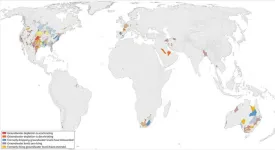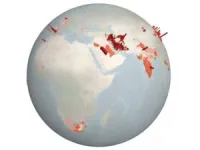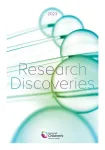(Press-News.org) (Santa Barbara, Calif.) — Groundwater is rapidly declining across the globe, often at accelerating rates. Writing in the journal Nature, UC Santa Barbara researchers present the largest assessment of groundwater levels around the world, spanning nearly 1,700 aquifers. In addition to raising the alarm over declining water resources, the work offers instructive examples of where things are going well, and how groundwater depletion can be solved. The study is a boon for scientists, policy makers and resource managers working to understand global groundwater dynamics.
“This study was driven by curiosity. We wanted to better understand the state of global groundwater by wrangling millions of groundwater level measurements,” said lead author Debra Perrone, an associate professor in UC Santa Barbara’s Environmental Studies Program.
The team compiled data from national and subnational records and the work of other agencies. The study took three years, two of which were spent just cleaning and sorting data. That’s what it takes to make sense of 300 million water level measurements from 1.5 million wells over the past 100 years.
Next came the task of translating the deluge of data into actual insights about global groundwater trends. The researchers then scoured over 1,200 publications to reconstruct aquifer boundaries in the regions of inquiry and evaluate groundwater level trends in 1,693 aquifers.
Their findings provide the most comprehensive analysis of global groundwater levels to date, and demonstrate the prevalence of groundwater depletion. The work revealed that groundwater is dropping in 71% of the aquifers. And this depletion is accelerating in many places: the rates of groundwater decline in the 1980s and ’90s sped up from 2000 to the present, highlighting how a bad problem became even worse. The accelerating declines are occurring in nearly three times as many places as they would expect by chance.
Groundwater deepening is more common in drier climates, with accelerated decline especially prevalent in arid and semi-arid lands under cultivation — “an intuitive finding,” said co-lead author Scott Jasechko, an associate professor in the university’s Bren School of Environmental Science & Management. “But it’s one thing for something to be intuitive. It’s quite another to show that it’s happening with real-world data.”
On the other hand, there are places where levels have stabilized or recovered. Groundwater declines of the 1980s and ’90s reversed in 16% of the aquifer systems the authors had historical data for. However, these cases are only half as common as would be expected by chance.
“This study shows that humans can turn things around with deliberate, concentrated efforts,” Jasechko said.
Take Tucson, Arizona for instance. Water allotted from the Colorado River is used to replenish the aquifer in the nearby Avra Valley. The project stores water for future use. “Groundwater is often viewed as a bank account for water,” Jasechko explained. “Intentionally refilling aquifers allows us to store that water until a time of need.”
Communities can spend a lot of money building infrastructure to hold water above ground. But if you have the right geology, you can store vast quantities of water underground, which is much cheaper, less disruptive and less dangerous. The stored groundwater can also benefit the region’s ecology. In fact, while preparing a research brief in 2014, Perrone found that aquifer recharge can store six times more water per dollar than surface reservoirs.
Tucson’s groundwater recharge is a boon for the local aquifer; however, withdrawals have caused the mighty river to dwindle above ground. The Colorado rarely reaches its delta in the California Gulf anymore. “These groundwater interventions can have tradeoffs,” Jasechko acknowledged.
Another option is to focus on reducing demand. Often this involves regulations, permitting and fees for groundwater use, Perrone explained. To this end, she is currently examining water law in the western U.S. to understand these diverse interventions. Regardless of whether it comes from supply or demand, aquifer recovery seemed to require intervention, the study revealed.
The authors complemented measurements from monitoring wells with data from the Gravity Recovery and Climate Experiment (GRACE). The GRACE mission consists of twin satellites that precisely measure the distance between them as they orbit the Earth. In this way, the crafts detect small fluctuations in the planet’s gravity, which can reveal the dynamics of aquifers at large scales.
“The beauty of GRACE is that it allows us to explore groundwater conditions where we don’t have in-situ data,” Perrone said. “Our assessment complements GRACE. Where we do have in-situ data, we can explore groundwater conditions locally, a crucial level of resolution when you’re managing depletion.” This local resolution is critical, as the authors found out, because adjacent aquifers can display different trends.
That said, groundwater level trends don’t present the whole picture. Even where aquifers remain stable, withdrawing groundwater can still affect nearby streams and surface water, causing them to leak into the subsurface, as Perrone and Jasechko detailed in another Nature paper in 2021.
The authors also analyzed precipitation variability over the past four decades for 542 aquifers. They found that 90% of aquifers where declines were accelerating are in places where conditions have gotten drier over the last 40 years. These trends have likely reduced groundwater recharge and increased demand. On the other hand, climate variability can also enable groundwater to rebound where conditions become wetter.
This study of monitoring wells complements a paper Perrone and Jasechko released in 2021. That study represented the largest assessment of global groundwater wells, and made the cover of the journal Science. “The monitoring wells are telling us information about supply. And the groundwater wells are telling us information about demand,” Perrone said.
“Taken together, they allow us to understand which wells have run dry already, or are most likely to run dry if groundwater-level declines occur,” Jasechko added.
Perrone and Jasechko are now examining how groundwater levels vary over time in the context of climate change. Connecting these rates of change to the depths of actual wells will provide better predictions of where groundwater access is at risk.
“Groundwater depletion is not inevitable,” Jasechko said. Fine resolution, global studies will enable scientists and officials to understand the dynamics of this hidden resource.
END
Global groundwater depletion is accelerating, but is not inevitable
Aquifers are declining worldwide, put success stories highlight that proactive management can reverse these trends
2024-01-24
ELSE PRESS RELEASES FROM THIS DATE:
Targeted scientific research projects to demonstrate effectiveness of ‘food is medicine’ in health care
2024-01-24
DALLAS, Jan. 24, 2024 — In an effort to identify effective food is medicine approaches for incorporating healthy food into health care delivery, the American Heart Association, the world’s leading voluntary organization focused on heart and brain health research, now celebrating 100 years of lifesaving work, today announced grants totaling $7.8 million to 19 research projects nationwide as part of its Health Care by Food™ initiative.
The research projects focus on areas including food resource coaching for patients of a safety-net clinic, delivering food is medicine interventions ...
Mass General Cancer Center announces first recipients of Krantz Awards for Cancer Research
2024-01-24
The Krantz Family Center for Cancer Research at the Mass General Cancer Center today announced the selection of 17 scientists who have been awarded a combined $6 million in funding. These competitive awards, which will be granted annually, were established to recognize the trailblazing efforts of Krantz Center scientists and accelerate ideas, projects and initiatives with the potential to fundamentally change how cancer is diagnosed and treated.
Philanthropists Jason and Keely Krantz, who ...
A large percentage of European plastic sent to Vietnam ends up in nature
2024-01-24
Despite strict EU regulations on plastic recycling, there is little oversight on plastic waste shipped from the EU to Vietnam. A large percentage of the exported European plastic cannot be recycled and gets dumped in nature. That is what new research led by Utrecht University’s Kaustubh Thapa has found.
Following the recycling path
About half of Europe’s plastic waste is exported to a number of countries in the Global South, including Vietnam. A Dutch and Vietnamese research team ventured to Minh Khai Craft Village, the largest recycling hub ...
A year of breakthroughs from Cincinnati Children’s
2024-01-24
Cincinnati Children’s continues to be a cradle for great discoveries.
Our latest Research Annual Report, online now, recounts a remarkable year of scientific advancement supported by a record-high level of research funding from federal, state, industry and philanthropic sources.
Among the many accomplishments from more than 1,000 faculty working in 50 research areas:
Promising results from the world’s first clinical trial of FLASH proton therapy for cancer treatment
Developing the first intestine organoids with functional immune cells, a major step closer to testing potential treatments using these amazing lab-grown tissues
Completing ...
AMS Science Preview: The “Black Swan” heatwave; volcanic chillers; tornadogenesis
2024-01-24
The American Meteorological Society continuously publishes research on climate, weather, and water in its 12 journals. Many of these articles are available for early online access–they are peer-reviewed, but not yet in their final published form.
Below is a selection of articles published early online recently. To view full article text, members of the media can contact kpflaumer@ametsoc.org for press login credentials.
Searching for the Most Extreme Temperature Events in Recent History
Bulletin ...
Ultrasounds can help predict the risk of preterm births, new research shows
2024-01-24
Researchers have developed a way to use ultrasound to predict whether a pregnant person is at risk of delivering a baby prematurely, which occurs in upward of 10% of pregnancies in the U.S.
The new method — the result of more than 20 years of collaboration between researchers in nursing and engineering at University of Illinois Chicago and University of Illinois Urbana-Champaign — measures microstructural changes in a woman’s cervix using quantitative ultrasound. The ultrasound method works as early as 23 weeks into a pregnancy, according to the research, which is published in ...
Exposure to flame retardants linked to premature birth, higher birth weight
2024-01-24
(SACRAMENTO, Calif.) — In the largest study of its kind, researchers at UC Davis Health found that exposure to organophosphate ester flame retardants during pregnancy was associated with preterm birth, especially among females. The chemicals were also linked to higher birth weight, a concern for increased obesity risk. The major new research study was published in Environmental Health Perspectives.
“The importance of this study lies in unraveling the potential impact of exposure to environmental chemicals during pregnancy on fetal development. Our findings guide our understanding of how these chemicals may be silently seeding lasting challenges ...
How a protein fights off bacteria
2024-01-24
The human immune system is constantly fending off a wide range of invaders – a feat that requires a diverse array of cellular troops and molecular weaponry. Although a great deal is already known about immune defense cells and the strategies they employ, many molecular details have remained elusive. Now a research team led by Professor Oliver Daumke, a lab head at the Max Delbrück Center, has managed to unravel the main activation mechanism of GBP1, a protein that plays a pivotal role in combating certain bacteria. They report in “The EMBO ...
Breakthrough technology offers promising treatment for ischemic retinopathy
2024-01-24
A groundbreaking technology with immense potential in treating ischemic retinopathy in premature infants and diabetic patients has been developed by Professor Byoung Heon Kang and his research team in the Department of Biological Sciences at UNIST, in collaboration with Professor Dong Ho Park’s team at Kyungpook National University Hospital. Ischemic retinopathy, characterized by the breakdown of the blood-retinal barrier and abnormal blood vessel growth, often leads to vision impairment and loss. The researchers have identified the critical role of a mitochondrial ...
Death rate higher than expected for patients with functional, nonepileptic seizures
2024-01-24
The death rate for patients with functional, nonepileptic seizures is higher than expected, with a rate comparable to epilepsy and severe mental illness, a Michigan Medicine-led study finds.
A team of researchers reviewed data from 700 patients who were diagnosed with functional seizures, also called psychogenic or nonepileptic seizures, between 2014 and mid-2023 and followed for a median of 15 months.
It is the largest study of its kind in the United States, matching international studies in Australia, Denmark, Sweden and the United Kingdom, all of which have nationalized health care systems.
Of the 700 patients with functional ...
LAST 30 PRESS RELEASES:
New expert guidance urges caution before surgery for patients with treatment-resistant constipation
Solar hydrogen can now be produced efficiently without the scarce metal platinum
Sleeping in on weekends may help boost teens’ mental health
Study: Teens use cellphones for an hour a day at school
After more than two years of war, Palestinian children are hungry, denied education and “like the living dead”
The untold story of life with Prader-Willi syndrome - according to the siblings who live it
How the parasite that ‘gave up sex’ found more hosts – and why its victory won’t last
When is it time to jump? The boiling frog problem of AI use in physics education
Twitter data reveals partisan divide in understanding why pollen season's getting worse
AI is quick but risky for updating old software
Revolutionizing biosecurity: new multi-omics framework to transform invasive species management
From ancient herb to modern medicine: new review unveils the multi-targeted healing potential of Borago officinalis
Building a global scientific community: Biological Diversity Journal announces dual recruitment of Editorial Board and Youth Editorial Board members
Microbes that break down antibiotics help protect ecosystems under drug pollution
Smart biochar that remembers pollutants offers a new way to clean water and recycle biomass
Rice genes matter more than domestication in shaping plant microbiomes
Ticking time bomb: Some farmers report as many as 70 tick encounters over a 6-month period
Turning garden and crop waste into plastics
Scientists discover ‘platypus galaxies’ in the early universe
Seeing thyroid cancer in a new light: when AI meets label-free imaging in the operating room
Neutrophil-to-lymphocyte ratio may aid risk stratification in depressive disorder
2026 Seismological Society of America Annual Meeting
AI-powered ECG analysis offers promising path for early detection of chronic obstructive pulmonary disease, says Mount Sinai researchers
GIMM uncovers flaws in lab-grown heart cells and paves the way for improved treatments
Cracking the evolutionary code of sleep
Medications could help the aging brain cope with surgery, memory impairment
Back pain linked to worse sleep years later in men over 65, according to study
CDC urges ‘shared decision-making’ on some childhood vaccines; many unclear about what that means
New research finds that an ‘equal treatment’ approach to economic opportunity advertising can backfire
Researchers create shape-shifting, self-navigating microparticles
[Press-News.org] Global groundwater depletion is accelerating, but is not inevitableAquifers are declining worldwide, put success stories highlight that proactive management can reverse these trends






